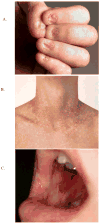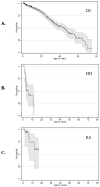Dyskeratosis congenita
- PMID: 19327580
- PMCID: PMC2702847
- DOI: 10.1016/j.hoc.2009.01.003
Dyskeratosis congenita
Abstract
Dyskeratosis congenita (DC) is an inherited bone marrow failure syndrome characterized clinically by the triad of abnormal nails, reticular skin pigmentation, and oral leukoplakia, and is associated with high risk of developing aplastic anemia, myelodysplastic syndrome, leukemia, and solid tumors. Patients have very short germline telomeres, and approximately half have mutations in one of six genes encoding proteins that maintain telomere function. Accurate diagnosis of DC is critical to ensure proper clinical management, because patients who have DC and bone marrow failure do not respond to immunosuppressive therapy and may have increased morbidity and mortality associated with hematopoietic stem cell transplantation.
Figures



References
-
- Drachtman RA, Alter BP. Dyskeratosis congenita: clinical and genetic heterogeneity. Report of a new case and review of the literature. Am J Pediatr Hematol Oncol. 1992;14(4):297–304. - PubMed
-
- Walne AJ, Dokal I. Dyskeratosis Congenita: a historical perspective. Mech Ageing Dev. 2008;129(12):48–59. - PubMed
-
- Mitchell JR, Wood E, Collins K. A telomerase component is defective in the human disease dyskeratosis congenita. Nature. 1999;402(6761):551–555. - PubMed
Publication types
MeSH terms
Grants and funding
LinkOut - more resources
Full Text Sources

